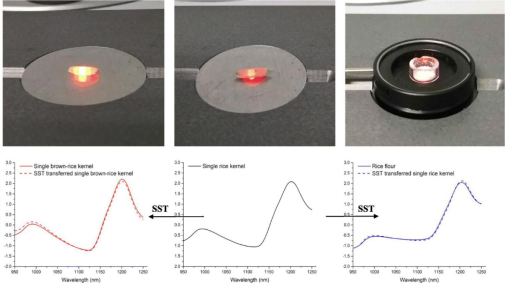[ Instrument Network Instrument Development ] Recently, the research team of Wu Yuejin, a researcher at the Institute of Technical Biology, has made new progress in crop single-particle near-infrared spectroscopy. Related work has been published online by the Spectrochimica Acta Part A: Molecular and Biomolecular Spectroscopy.
The SST algorithm can transfer the near-infrared diffuse transmission spectra of three forms of rice (single-grain rice, single-grain brown rice, rice flour)
Single-particle near-infrared detection (SKNIRS) refers to the detection of crop components using near-infrared spectroscopy at the individual crop level. Because of its fast and non-destructive advantages, this technology is expected to be applied to the breeding industry to improve crop breeding efficiency and shorten the breeding cycle. However, due to the spectral absorption of crop hulls, the uneven distribution of particle morphology and composition of single crops, and the low accuracy of chemical detection methods at the single-grain level, the accuracy of SKNIRS analysis results is limited, which limits the breeding of the technology. application.
To this end, Wu Yuejin's research team proposed a single-particle near-infrared detection technique based on model transfer optimization method, and explored the application of this method by taking the protein content detection of single-grain rice as an example. Model transfer is often applied to spectral correction between different instruments and was innovatively applied to solve single-particle detection problems in this study. Through a model transfer algorithm-spectral space conversion (SST), the research group transferred the single-grain rice into the spectral form of single-grain brown rice and rice flour, and predicted it with a single-grain brown rice and rice flour model. The spectrum after the SST algorithm is similar to the real spectrum, and the prediction results are close to or even better before the transition. Thus, the difficulties encountered in the near-infrared spectroscopy of single crops are expected to be overcome by the method of transferring the spectra into other forms of the crop. The method enriches the single-grain crop spectrum detection method, and is expected to be popularized and applied in the detection of more single crop components.
The work was supported by the Science and Technology Special Project of the Chinese Academy of Sciences and the National Natural Science Foundation.
(Original title: New progress in single-particle near-infrared detection technology for crops where technical organisms are located)
X Ray Machine
The system matches with metal ceramic X-ray tube and high
frequency solid insulate industrial X-ray HT generator, it applies forced
cooling system to make sure X-ray machine can normally continuous work for 24
hours. The dimension of this kind of small focus X-ray tube is half of
traditional focus tube, geometry unintelligibility is an important factor which
affects image quality, if focus bigger, correspondingly, geometry
unintelligibility is deeper, and also makes image edge much more blur; if focus
smaller, geometry unintelligibility is lighter, it can improves image quality
at same time, also focus is smaller can inspect smaller failure which is favor
to improve X-ray RTR inspection stability.
The controlling part of system is researched and
manufactured by ourselves, the intelligent main control PLC works matches with
touch screen, beautiful and complete functional stainless steel panel that can
display and adjust parameters much more convenient. When high voltage of system
opens, there will be red light alarming signal outside of protect door, here
installs interlock devices between lead door and system, in the case of opening
lead door, system will stop radiation at once to assure safety of operators.
Units For X Ray RTR System
Butt Weld Pipe RTR System,Boiler Pipe RTR System,Casting RTR System,Wheel Hub RTR System
Dandong Nondestructive Testing Equipment Co., Ltd. , http://www.ddchinaxray.com
